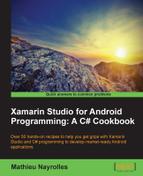NFC stands for Near Field Communication and allows NFC-equipped owners to exchange data by contact (or near contact) of their phones. In Android, we can use NFC through Beam. Using Beam, users can exchange a small amount of data, such as web bookmarks, contact info, directions, YouTube videos links, and so on. NFC is more convenient than other wireless technologies, such as Bluetooth or Wi-Fi for quickly sending data as no pairing or authentication is required.
Create a new Solution named Beam_Project. To test this recipe, you'll need to deploy your application on two different NFC-enabled phones, as the emulator doesn't support NFC. Also, we will need to add the NFC permission.
To complete this recipe, you need to perform the following steps:
- Import the NFC APIs by adding
using Android.Nfcat the top of theMainActivity.csfile. - Import text capacities by adding the
System.Textelement at the top of theMainActivity.csfile. - In the
MainActivity.csfile, implement theNfcAdapter.ICreateNdefMessageCallbackandNfcAdapter.IOnNdefPushCompleteCallbackinterfaces, as shown in the following code:public class MainActivity : Activity, NfcAdapter.ICreateNdefMessageCallback, NfcAdapter.IOnNdefPushCompleteCallback
- Add a
TextViewelement in theMain.axmlfile and create a reference to it in yourOnCreate()method:TextView textView = FindViewById<TextView> (Resource.Id.mytextView);
- Test if the device is NFC enabled by adding the following snippet in the
OnCreate()method of yourMainActivityclass:NfcAdapter nfcAdapter = NfcAdapter.GetDefaultAdapter(this); if (nfcAdapter == null) { Console.WriteLine ("Not NFC enabled"); textView.Text = "Not NFC"; } else { textView.Text = "NFC OK"; nfcAdapter.SetNdefPushMessageCallback (this, this); nfcAdapter.SetOnNdefPushCompleteCallback (this, this); } - Create a private constant named
message_idand assign its value as1:private const int message_id = 1;
- Implement the
OnNdefPushComplete()method defined by theNfcAdapter.IOnNdefPushCompleteCallbackinterface as follows:public void OnNdefPushComplete (NfcEvent myNfcEvent) { Handler myHandler = new Handler (); myHandler.ObtainMessage (message_id).SendToTarget (); } - Implement the
CreateNdefMessage()method defined by theNfcAdapter.ICreateNdefMessageCallbackinterface as follows:public NdefMessage CreateNdefMessage (NfcEvent myNfcEvent) { String myBeamText = ("MyAwesomeBeamMessage"); byte [] mimeBytes = Encoding.UTF8.GetBytes ("application/com.example.android.beam"); NdefRecord ndefRecord = new NdefRecord ( NdefRecord.TnfMimeMedia, mimeBytes, new byte [0], Encoding.UTF8.GetBytes (myBeamText)); NdefMessage myBeamMessage = new NdefMessage (new NdefRecord[]{ ndefRecord }); return myBeamMessage; } - Create a
displayMessage()method that takes anIntentobject as an argument:protected void displayMessage (Intent intent) { IParcelable [] parcelMessage = intent.GetParcelableArrayExtra (NfcAdapter.ExtraNdefMessages); NdefMessage msg = (NdefMessage) parcelMessage [0]; TextView textView = FindViewById<TextView> (Resource.Id.mytextView); textView.Text = Encoding.UTF8.GetString (msg.GetRecords () [0].GetPayload ()); } - Override the
OnResume()andOnNewIntent()methods as follows:protected override void OnResume () { base.OnResume (); if (NfcAdapter.ActionNdefDiscovered == Intent.Action) { displayMessage (Intent); } } protected override void OnNewIntent (Intent intent) { Intent = intent; } - Deploy your application and two different phones, launch the application on those phones, and then put their NFC chips close to each other. You'll receive a New Tag Collected message that contains the name of your APK.
Android Beam allows us to beam messages from one phone to another as long as they are close enough to each other (almost in contact) and own an NFC chip. The messages that can be sent via beam are NFC Data Exchange Format Message (NdefMessage), which are composed of one or more NdefRecords. This is a convenient way to encapsulate data in a binary format for NFC transfer. NdefRecords have the following four attributes:
- Tnf: This is a type of data
- Type: This is the type of application that should receive the message
- Id: This is the ID of the message
- Playload: This is the actual content
The name of the attributes can be confusing. The Tnf attribute defines what the type of data is. For example, we can use TnfMimeMedia or TnfAbsoluteUri, which are public constants of the NdefRecord class. The Type attribute refers to the application that should handle your message, such as application/com.example.android.beam.
To build our NdefRecords() method we used the following constructor:
public NdefRecord (short tnf, byte[] type, byte[] id, byte[] payload)
Also, we used the following code:
byte [] type = Encoding.UTF8.GetBytes ("application/com.example.android.beam");
NdefRecord mimeRecord = new NdefRecord (
ndefRecord.TnfMimeMedia, type , new byte [0], Encoding.UTF8.GetBytes (myBeamText));In this snippet, we first create an array of the byte representing "application/com.example.android.beam". This array will be used as the Type argument of the NdefRecords() method. Then, we call the constructor with NdefRecord.TnfMimeMedia as the Tnf argument, our newly created array of bytes named type, and MyAwesomeBeamMessage is also transformed into bytes by means of the Encoding helper.
We now have every piece required to construct our NdefMessage() method with the following:
NdefMessage myBeamMessage = new NdefMessage (new NdefRecord[]{ ndefRecord });In order to receive beam messages, we created the displayMessage() method that takes an Intent as an argument:
protected void displayMessage (Intent intent) {
IParcelable [] parcelMessage = intent.GetParcelableArrayExtra (NfcAdapter.ExtraNdefMessages);
NdefMessage msg = (NdefMessage) parcelMessage [0];
TextView textView = FindViewById<TextView> (Resource.Id.mytextView);
textView.Text = Encoding.UTF8.GetString (msg.GetRecords () [0].GetPayload ());
}Then, the displayMessage() method is called by the OnResume() method if our application is resumed by an NFC call:
protected override void OnResume () {
base.OnResume ();
if (NfcAdapter.ActionNdefDiscovered == Intent.Action) {
displayMessage (Intent);
}
}In the displayMessage() method, we first get an array of the parcelable object and cast the first one as NdefMessage. Indeed, this method will be called only in case of beam contact, and we can only send one beam message at a time. Therefore, we can safely execute (NdefMessage) parcelMessage [0]. Finally, we assign our textview text with the Payload argument of the first record of our message.
The activity we created is able to send and receive beam messages because it implements the related interface and will register itself as a beam application.
You can also visit the following links:
- http://developer.android.com/guide/topics/connectivity/nfc/nfc.html for the in depth specification of NFC for Android
- http://open-nfc.org/wp/ if you would like to use NFC on your emulators or https://github.com/xamarin/monodroid-samples/blob/master/AndroidBeamDemo/AndroidBeamDemo/Activity.cs
